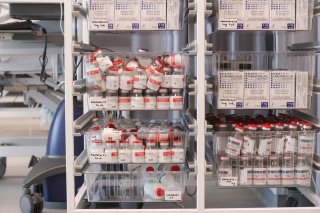Coronavirus Help: Here's How to Model a Pandemic
Let's take a closer look.
The fraction of the population that needs to be immune to protect the rest varies depending on how infectious the disease is. The basic reproduction number, R₀, holds the key to how large that proportion is. The higher the basic reproduction number, the higher the immune proportion of the population needs to be. For example, for a disease with a basic reproduction number of 4, the S-I-R model predicts that three-quarters of the population must be immune. If R₀ is as low as 1.5 then potentially only one-third of the population needs to acquire immunity to protect the remaining two-thirds.
If a vaccine is available, then herd immunity can be achieved by vaccinating a sufficiently high proportion of the population (that said, we have only ever managed to completely wipe out one human disease – smallpox – through vaccination).
When a vaccine isn’t available, the only way for people to acquire immunity is to become infected with the disease and recover. Given the case fatality rate of COVID-19, this would entail the deaths of many thousands of people. Unsurprisingly, the UK government backtracked on their proposed policy.
The next generation of modelling
In reality, the simple S-I-R model is not complex enough to capture the subtleties of many infectious disease outbreaks. But for diseases which confer no immunity on their victims, a simple adaptation of the S-I-R model can help.
As is typical of some sexually transmitted diseases, gonorrhoea has no removed population at all. Once recovered from gonorrhoea, patients can be infected again. Since no one dies from the symptoms of gonorrhoea, no one is ever “removed” from the population. Such models are typically labelled S-I-S, mimicking the progression pattern of an individual from susceptible to infective and back to susceptible again. Since the population of susceptible people is never exhausted, but renewed as people recover, the S-I-S model predicts that diseases can become self-sustaining or “endemic”.
Whether a single infection with SARS-CoV-2 (the virus that causes COVID-19) was enough to provide immunity was one of the main worries for scientists at the beginning of the outbreak. Could the novel virus circulate indefinitely in the population? Although there have been several reports of people catching the virus for a second time, there is also good evidence to suggest that recovered COVID-19 patients become immune.
Another problem with the novel coronavirus is that there is typically an asymptomatic period at the start of the disease. During this time, people can harbour the virus and infect others without showing symptoms themselves. That means we need to add another class of people to the model. These are people who, once infected, are capable of passing on the disease while displaying no symptoms - the so-called “carrier” class. This changes the S-I-R model into an S-C-I-R model. The carrier class is vital for representing diseases such as HIV/AIDS, which have long infectious periods with no obvious symptoms.
The state-of-the-art models that are currently being used to inform government policy are even more complicated. Unfortunately, even the most detailed and realistic of mathematical models is not capable of predicting when the current pandemic will be brought to heel.
But it is certain that, when we eventually wrest control of the situation, mathematicians and their models will have played a significant role in the way in which the drama panned out.
Christian Yates, Senior Lecturer in Mathematical Biology, University of Bath
This article is republished from The Conversation under a Creative Commons license. Read the original article.
Image: Reuters.

